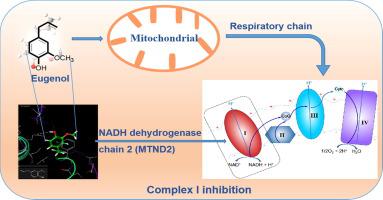Journal of Advanced Research ( IF 10.7 ) Pub Date : 2020-12-28 , DOI: 10.1016/j.jare.2020.12.010 Xiao-Fei Shang 1, 2 , Li-Xia Dai 1 , Chen-Jie Yang 2 , Xiao Guo 3 , Ying-Qian Liu 2 , Xiao-Lou Miao 1 , Ji-Yu Zhang 1

|
Introduction
Eugenol is a major component of essential oils of several plants, it exhibits significant antiparasitic and acaricidal activities, yet its molecular targets remain unknown.
Objectives
We aimed to systematically investigate the mechanism of action and the potential targets of eugenol against P. cuniculi, and evaluate the safety for laying the theoretical foundation for clinical application as an acaricide.
Methods
Using RNA-Seq analysis, surface plasmon resonance analysis and RNA interference assay, the mode of action of eugenol against Psoroptes cuniculi was investigated. The effect on the mitochondrial membrane potential and complex I of PC12 cells and C6/36 cells was assayed to investigate the species specificity of eugenol in insects and mammals. Finally, a safety evaluation of eugenol in vivo was performed.
Results
Eugenol inhibited complex I activity of the mitochondrial respiratory chain in the oxidative phosphorylation pathway by binding to NADH dehydrogenase chain 2 and resulted in the death of mites. The inhibition rates were 37.89% for 50 μg/mL and 60.26% for 100 μg/mL, respectively. Further experiments indicated that the difference in the complex I sequence between insects and mammals led to the different affinity of eugenol to specific peptide, resulting in species specificity. Eugenol exhibited significant inhibitory effects against the mitochondrial membrane potential and complex I in Aedes albopictus C6/36 cells but was not active in rat PC12 cells. Insect cells were particularly sensitive to eugenol. In contrast to the known inhibitor rotenone, eugenol had better safety and did not result in Parkinson’s disease or other diseases in rats.
Conclusion
This is the first report on acaricidal eugenol targeting complex I of the mitochondrial respiratory chain. This work lays the foundation for the development of eugenol as an environmentally alternative acaricidal agent.
中文翻译:

丁香酚作为杀螨剂的增值应用:作用机制和安全性评价
介绍
丁香酚是几种植物精油的主要成分,具有显着的抗寄生虫和杀螨活性,但其分子靶点仍然未知。
目标
我们旨在系统地研究丁香酚对P. cuniculi的作用机制和潜在靶点,并评估其安全性,为临床应用作为杀螨剂奠定理论基础。
方法
使用 RNA-Seq 分析、表面等离子共振分析和 RNA 干扰测定,研究了丁香酚对Psoroptes cuniculi的作用方式。测定了对PC12细胞和C6/36细胞线粒体膜电位和复合物I的影响,以研究丁香酚在昆虫和哺乳动物中的物种特异性。最后,进行了丁香酚在体内的安全性评价。
结果
丁香酚通过与 NADH 脱氢酶链 2 结合,抑制线粒体呼吸链在氧化磷酸化途径中的复合物 I 活性,并导致螨虫死亡。50 μg/mL 的抑制率分别为 37.89% 和 100 μg/mL 的 60.26%。进一步的实验表明,昆虫和哺乳动物之间复合物I序列的差异导致丁香酚对特定肽的亲和力不同,从而产生物种特异性。丁香酚对白纹伊蚊的线粒体膜电位和复合物 I 表现出显着的抑制作用C6/36 细胞,但在大鼠 PC12 细胞中没有活性。昆虫细胞对丁香酚特别敏感。与已知的抑制剂鱼藤酮相比,丁香酚具有更好的安全性,不会导致大鼠帕金森病或其他疾病。
结论
这是针对线粒体呼吸链复合物 I 的杀螨丁香酚的首次报道。这项工作为丁香酚作为环境替代杀螨剂的开发奠定了基础。



























 京公网安备 11010802027423号
京公网安备 11010802027423号